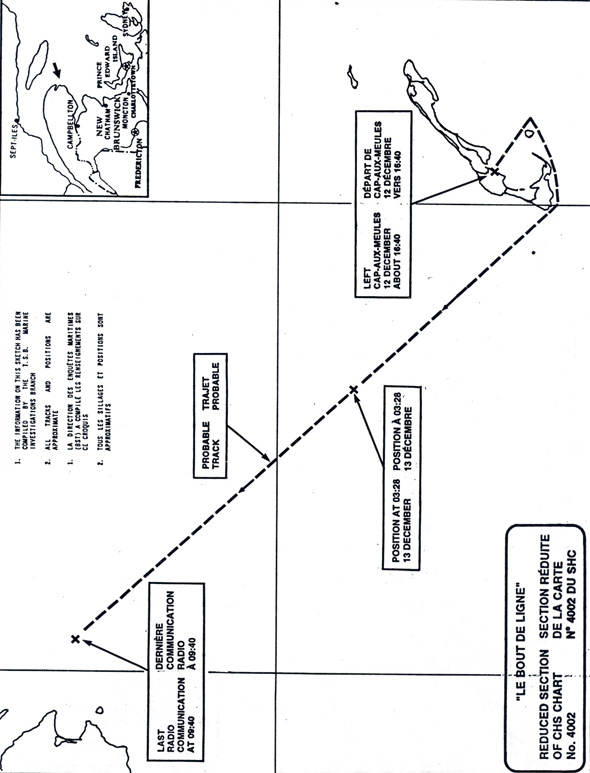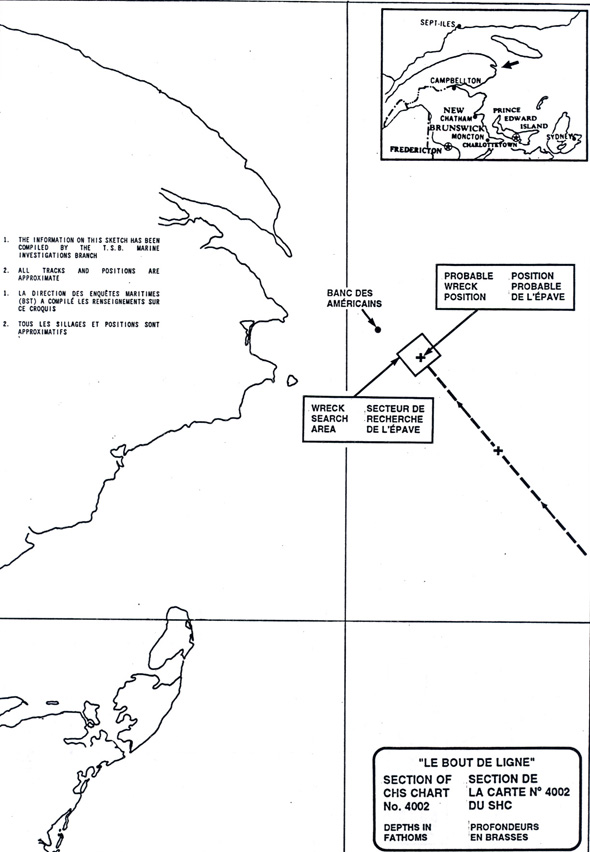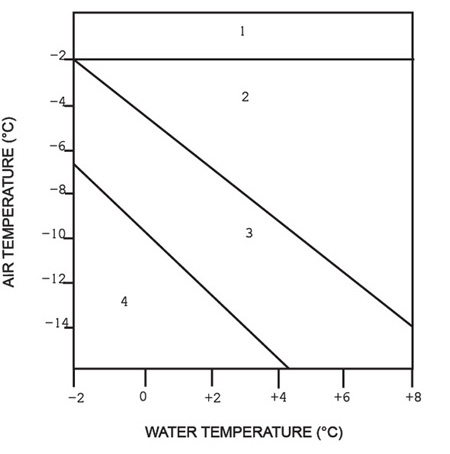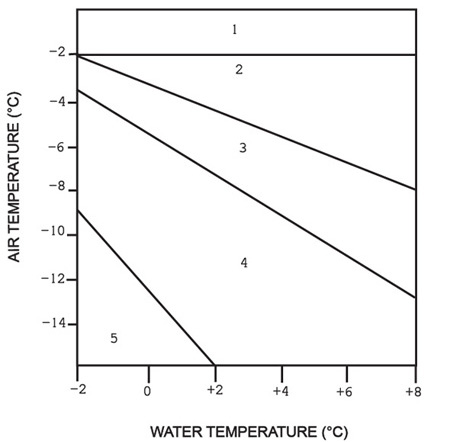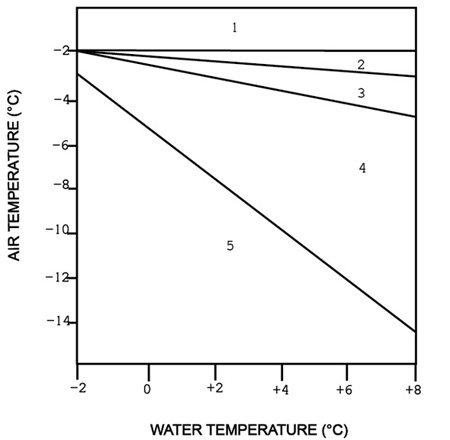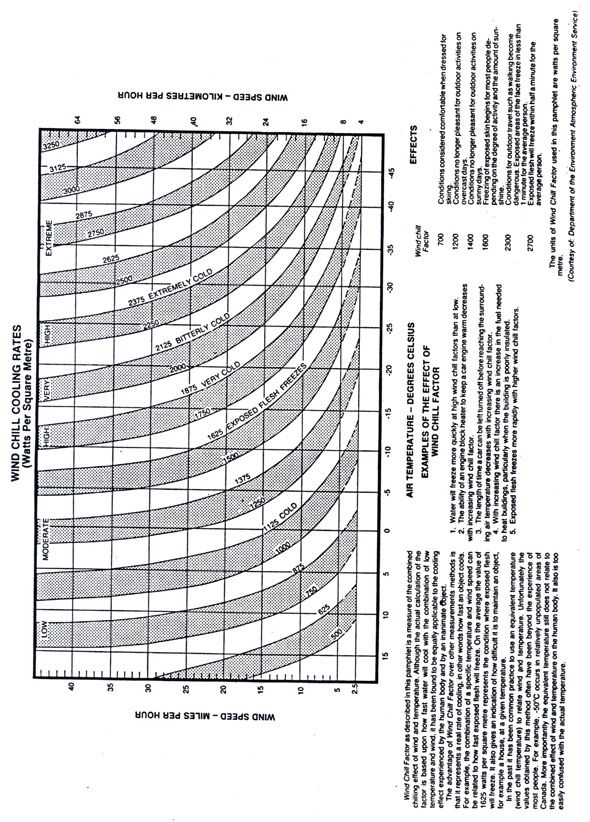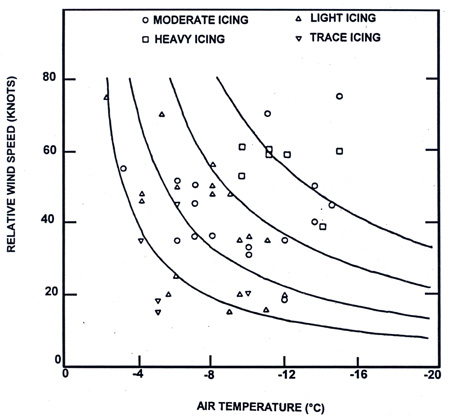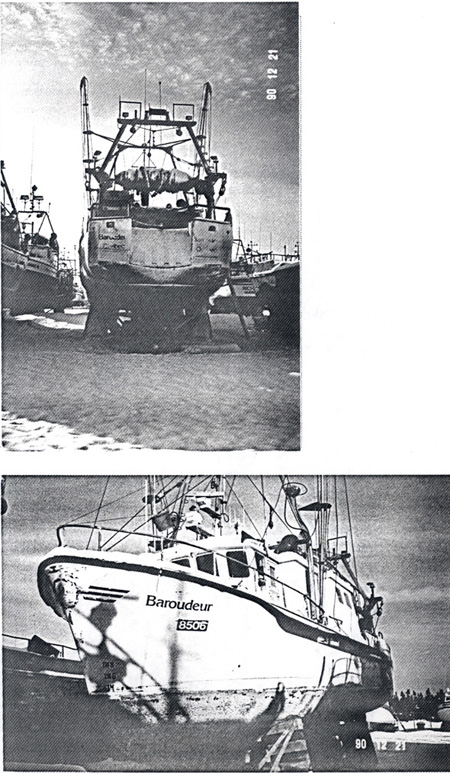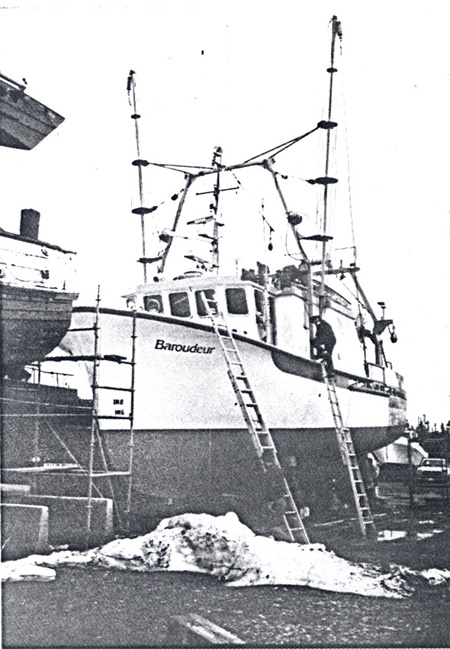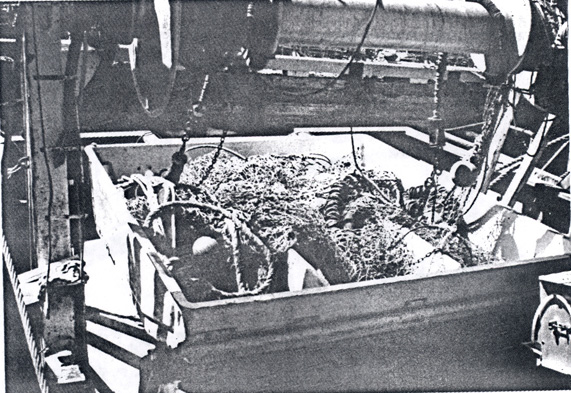Disappearance and Presumed Sinking
of the F.V. "LE BOUT DE LIGNE"
with the Loss of the Three Crew Members
Gulf of St. Lawrence
The Transportation Safety Board of Canada (TSB) investigated this occurrence for the purpose of advancing transportation safety. It is not the function of the Board to assign fault or determine civil or criminal liability. This report is not created for use in the context of legal, disciplinary or other proceedings. See Ownership and use of content. Masculine pronouns and position titles may be used to signify all genders to comply with the Canadian Transportation Accident Investigation and Safety Board Act (S.C. 1989, c. 3).
Summary
While en route from Cap-aux-Meules, Magdalen Islands, to Rivière-au-Renard, Quebec, in adverse weather conditions, the "LE BOUT DE LIGNE" disappeared on 13 December 1990 with the loss of all hands. The last known position was approximately 20 miles south-east of Cap Gaspé. Despite extensive Search and Rescue operations, no trace of either the vessel or the crew of three was found.
The Board determined that the most probable cause of the disappearance of the "LE BOUT DE LIGNE" is that the vessel suddenly capsized in adverse weather conditions due to a loss of transverse stability resulting from the cumulative effect of icing, running before breaking waves in light load condition and not stowing all the fishing gear at the lowest stowable level. The vessel, having capsized, would eventually have lost all reserve buoyancy and sunk.
1.0 Factual information
1.1 Particulars of the vessel
| "LE BOUT DE LIGNE" | |
|---|---|
| Official number | 802578 |
| Port of registry | Québec, Quebec |
| Flag | Canadian |
| Type | Glass-reinforced plastic stern trawler |
| Gross TonsNote de bas de page 1 | 58.8 |
| Length | 16.8 m |
| Breadth | 5.59 m |
| Depth | 2.83 m |
| Draught (estimated at time of occurrence) | FNote de bas de page 2: 1.9 m A: 2.3 m |
| Built | 1983, St-Antoine de Tilly, Quebec |
| Propulsion | One 340 BHP diesel engine, driving a single fixed-pitch propeller, speed about 9 knots |
| Owner | Norman O'Connor Cap-des-Rosiers, Quebec |
1.1.1 Description of the vessel
The "LE BOUT DE LIGNE" was the first of a total of 47, 16.8 m (55 ft) long fishing vessels, built in 1983 at St-Antoine de Tilly by AMT Marine Inc. Although all these vessels had a glass-reinforced plastic (GRP) hull from the same mould, several versions were built for the various fishing operations. Only four other vessels are truly identical to the "LE BOUT DE LIGNE" (AMT series 200).
1.2 History of the voyage
The "LE BOUT DE LIGNE" had been fishing in fishing zone 4T near the coast of Nova Scotia since mid-November. The vessel, having completed fishing for the season, departed Chéticamp, Nova Scotia, on 10 December 1990, in a light load condition, bound for Rivière-au-Renard, Quebec, the vessel's home port. That evening, the small trawler called at Cap-aux-Meules, Magdalen Islands, and remained there just under two days while waiting for weather conditions to improve.
In the afternoon of 12 December, the strong north-westerly winds diminished, and the weather reports called for the wind to veer to the south-east shortly. The "LE BOUT DE LIGNE" thus departed from Cap-aux-Meules around 1640Note de bas de page 3 and advised the Coast Guard Radio Station (CGRS) at Cap-aux-Meules (call sign VCN) that the vessel intended to proceed toward Le Corps-Mort Island, then directly to Cap Gaspé; a distance of about 170 miles. (See Appendix A)
The following morning at 0328, the "LE BOUT DE LIGNE" reported to VCN that she was 78.3 miles from Cap Gaspé, that the vessel's geographic coordinates were 47°46'56"N, 062°46'56"W, and that she expected to pass Cap Gaspé around 1030 that morning. The skipper also indicated that the vessel's speed had been reduced in the vicinity of Le Corps-Mort Island due to freezing spray. Although anxiety was detected in his voice and he expressed concern that there were no other vessels around, there was nothing to indicate that the vessel was experiencing difficulty.
Around 0830, when the vessel was some 30 to 35 miles from Cap Gaspé, the "LE BOUT DE LIGNE" communicated with an individual, who was using a very high frequency radiotelephone (VHF R/T) from his residence near Rivière-au-Renard. A second and last communication with the same individual occurred around 0940, at which time the vessel was 20 miles south-east of Cap Gaspé; the vessel's speed was estimated by the skipper at 10.8 or 10.9 knots and the estimated time of arrival (ETA) Rivière-au-Renard was given at between 1330 and 1400.
Commencing at 1001, the fishing vessel "LINA ROBERT", stationed at Rivière-au-Renard, attempted unsuccessfully to establish VHF R/T contact with the "LE BOUT DE LIGNE". Further, there was no response to a series of calls made at 1110, on VHF R/T, by the local resident from his home. At 1410, the "LE BOUT DE LIGNE" was reported overdue to VCN, thus initiating official Search and Rescue (SAR) response at 1426.
1.3 Injuries to persons
| Crew | Passengers | Others | Total | |
|---|---|---|---|---|
| Fatal | - | - | - | - |
| Missing | 3 | - | - | 3 |
| Serious | - | - | - | - |
| Minor/None | - | - | - | - |
| Total | 3 | - | - | 3 |
1.4 Damage
1.4.1 Damage to the vessel
The vessel is presumed to have sunk and is considered a total loss.
1.4.2 Environmental damage
During the sinking of the vessel, some oil must have spilled into the waters and have been quickly dispersed by the action of the wind and the waves.
1.5 Certification
1.5.1 Vessel certification
Following the last scheduled inspection of the "LE BOUT DE LIGNE" by the Ship Safety Branch of the Canadian Coast Guard (CCG) on 08 April 1987, the vessel was issued a SIC 29 certificate. The certificate was short-termed to expire on 31 December 1990 to coincide with the upcoming tail shaft, rudder and pintles, and sea and storm valves inspections. The Ministry of Agriculture, Fisheries and Food of Quebec (MAPAQ) inspected the vessel in 1988 and 1990 for loan approval purposes, and the inspection reports indicated that the vessel was in appropriate condition; this inspection is not intended to replace the safety inspection required under the Small Fishing Vessel Inspection Regulations (SFVIR) and should not be confused with the latter.
1.5.1.1 Modifications to the Vessel and Inspections
A wooden fish box had first been installed aboard the "LE BOUT DE LIGNE" in 1983, shortly after the vessel was built. The CCG noted the existence of that box in 1985 during the roll tests (see section 1.12.6), and stated that it was very heavy and could, by itself, cause a substantial trim by the stern; however, no recommendations were made.
Stabilizers were installed aboard the "LE BOUT DE LIGNE" in the spring of 1988 and the installation was deemed satisfactory by the CCG, but no particular stability study was done.
In 1990, the stabilizer booms were replaced and a new aluminium fish box was installed; the latter being lighter than the replaced wooden fish box. However, it is not known why the stabilizer booms were replaced and whether the new stabilizer booms were lighter or heavier than the original booms. However, the CCG was not advised of these 1990 modifications.
The Canada Shipping Act (CSA) requires small fishing vessels to be inspected every four years. However, between inspections, as in this case, the owners carry out modifications to their vessels or add equipment without notifying the CCG. The onus is on the owners to notify the CCG of such modifications. There are no specific regulations regarding the specifications of fish boxes and stabilizers; however, according to section 377 (2) of the Act, when the hull or equipment is modified or renewed so as to affect its compliance with the regulations, the owner must inform the Ship Safety Branch of the CCG.
1.5.2 Personnel certification
There is no regulatory requirement under the CSA for a vessel of the size and type of the "LE BOUT DE LIGNE" to carry certificated personnel. However, the skipper was in possession of a Class IV Fishing Master's Certificate of Competency issued on 20 March 1980.
1.6 Personnel history
1.6.1 Skipper
The skipper had owned two small fishing vessels prior to purchasing the "LE BOUT DE LIGNE" in early 1990. He had served as a skipper for the last three seasons, the last few months aboard the "LE BOUT DE LIGNE". Further, he also served as a relief skipper on other small fishing vessels and, additionally, as a first mate on the large fishing vessels, "LUMAAQ" and "KRISTINA LOGOS". This was his sixth or seventh season fishing in the 4T fishing zone near the coast of Nova Scotia.
1.7 Weather and tidal information
The weather forecasts were broadcast continuously by the Gulf of St. Lawrence CGRS (call sign VCP). The skipper aboard the "LE BOUT DE LIGNE" had visited the VCN and was aware of the weather forecasts.
1.7.1 Forecasts
The weather forecast for the Gulf-Magdalen sector, issued by Environment Canada at 1600 on Wednesday, 12 December 1990, predicted north-westerly winds at 20 to 30 knots diminishing to slight during the night and winds increasing from the south-east at 30 gusting to 40 around noon on 13 December. A Gale Warning and a Freezing Spray Warning were in effect.
However, the freezing spray was forecast to cease around midnight. Snow squalls were predicted to start during the night, changing to rain squalls in the afternoon of the following day.
1.7.2 Weather as reported by the vessel
In the vessel's final communication at 0940, the "LE BOUT DE LIGNE" reported that the weather experienced was south-south-east winds at 35 knots, high seas and near-zero visibility in snow flurries.
1.7.3 Weather as recorded by the nearest recording station
A strong north-westerly wind of 25 to 35 knots was noted by other vessels in the Gulf of St. Lawrence until about midnight. The wind then veered to the south-east and quickly reached 25 to 35 knots. Visibility was poor at the time of the disappearance of the fishing vessel. The height of the waves as reported by the tug "IRVING MIAMI", operating off Cap Gaspé in deep waters, at 1430, 13 December, was 3.5 to 4.5 m.
1.7.4 Freezing spray and vessel icing
According to observations made by vessels in the Gulf of St. Lawrence that day, the air temperature was between −6 and −9°C at the time of the departure of the "LE BOUT DE LIGNE" from the Magdalen Islands. The temperature then rose slowly to approximately −4°C by 1000, 13 December, about the time of the last communication with the "LE BOUT DE LIGNE", and by 1300, it had reached near-freezing levels.
The temperature of the sea water, as reported by the vessels sailing in the Gulf, was 1 to 2°C. At 2200, 12 December, freezing spray with ice accretion on the superstructures was reported by the Canadian bulk carrier "SAUNIÈRE", positioned some 30 miles north-west of the Magdalen Islands.
When the "LE BOUT DE LIGNE" was in port (Magdalen Islands), the skipper had obtained wooden mallets to de-ice the vessel, if necessary. Although freezing spray was mentioned by the"LE BOUT DE LIGNE" during the radio communication with VCN at 0328, the amount of ice accretion on the deck and superstructure was not specified.
Several publications are available and widely distributed to the members of the fishing industry and interested parties. The causes of, dangers from, and precautions against ice accretion are covered in various Transport Canada publications, including the Manual of Safety and Health for Fishermen, TP 1283, which is based on the IMO Code of Safety for Fishermen and Fishing Vessels, and An Introduction to Fishing Vessel Stability, TP 8161, aimed at promoting safety through education. Cursory reference to vessel icing hazard is also contained in the Small Fishing Vessel Safety Manual, TP 10038.
The aforementioned publications, besides dealing with problems affecting the stability of the vessel, stress the need to keep all navigation equipment, including aerials and life-saving equipment, among others, free of ice.
1.8 Navigation equipment
1.8.1 Vessel equipment
The "LE BOUT DE LIGNE" was equipped with a Furuno LC90 Loran C interfaced with a Furuno GD180 video plotter. She was also equipped with a Furuno LC80 Loran C. Additionally, there were two Furuno radars: a FR810 with a range of 72 miles and a FR240 with a range of 24 miles.
The navigation equipment, intended for offshore navigation, was apparently in good working condition at the time of departure from the Magdalen Islands.
1.8.2 Shore equipment
There was no reported failure of shore-based navigation equipment that could have affected the outcome of the occurrence.
1.9 Radio communications
The "LE BOUT DE LIGNE" was equipped with one single side band (SSB) Hull 922 R/T, and two VHF R/Ts: a Sailor RT146 and a Cibernet 7660.
1.9.1 Vessel Traffic Services (VTS) and/or Coast Guard Radio Stations (CGRS)
The vessel traffic in the Gulf of St. Lawrence is under the operational jurisdiction of, and is governed by, the Eastern Canada Vessel Traffic Services Zone Regulations (ECAREG). It is not mandatory for vessels under 500 gross tons to participate in this system.
In case of an emergency or when a vessel is overdue, vital information on the vessel is essential for the authorities to initiate an effective SAR response. Thus, the CCG encourages fishing vessels and pleasure craft to prepare a sailing plan and to leave a copy with a responsible person ashore. In this instance, the sailing plan was left with the VCN. However, it should be noted that information provided in the sailing plans is primarily intended to launch an effective SAR operation, upon the vessel being declared overdue.
At the time of departure from the Magdalen Islands, VCN informed the"LE BOUT DE LIGNE" that the station was going to contact the CGRS Rivière-au-Renard (call sign VCG) to inform that station of the impending arrival of the vessel. VCN also urged the skipper to contact VCG at the time of the vessel's arrival. VCN first notified VCG about the "LE BOUT DE LIGNE" when she was reported overdue.
The VHF R/T channel 16 transmissions, between 0815 and 1510 on 13 December, picked up and recorded by VCG, were reviewed. However, no distress call or any other communication was identified that could have originated from the "LE BOUT DE LIGNE".
1.9.2 Quality of communication
The 0328 communication recorded by VCN showed that the reception of the vessel's transmission was good. However, the last two communications, at 0830 and 0940 respectively, with the local resident in Gaspé, were on VHF R/T channels 88B and 70 respectively, which are not designated CGRS frequencies and are neither monitored nor recorded by the CGRS.
During these last two transmissions, it was reported to the resident in Gaspé that the reception of the transmissions received aboard the "LE BOUT DE LIGNE" was good, whereas the reception of the transmissions received in Gaspé from the vessel was very weak. However, reception improved as the small vessel approached the coast. Reportedly, the skipper of the "LE BOUT DE LIGNE" informed the Gaspé resident that his best VHF R/T (the Sailor RT146) and the SSB R/T were not functioning, but no explanation was provided; the SSB R/T was non-operational at the time of the vessel's departure from Chéticamp.
A technician who visited the vessel in August 1990 confirmed that the two VHF R/Ts were working satisfactorily at the time of servicing.
1.10 Emergency equipment
1.10.1 Life-saving equipment
The vessel was equipped with 6 parachute pyrotechnic signals and 12 hand flares, a single Mustang floater suit, at least 3 lifejackets, a 4.3 m (14 ft) aluminium skiff and a six-person inflatable liferaft; the latter was last inspected and found satisfactory by the CCG on 03 May 1990. The liferaft was not required by regulations to be, nor was it, fitted with a hydrostatic release or any other float-free device.
Because the "LE BOUT DE LIGNE" was a vessel under 20 m in length and under 150 gross tons, she was neither required to carry an emergency position indicating radio beacon (EPIRB) under the EPIRB Regulations nor to carry survival suits under the SFVIR.
1.11 Search and rescue (SAR)
When the "LE BOUT DE LIGNE" was reported overdue to VCG at 1410 on 13 December by the "LINA ROBERT", VCG immediately notified the Marine Rescue Sub-centre (MRSC) Québec thus initiating official SAR response. The fishing vessels were the first to depart from Rivière-au-Renard headed toward the vessel's last known position. They continued their search until the next morning under adverse weather conditions due to the storm-force winds and freezing spray. The initial search area was between Cap-des-Rosiers and Cap d'Espoir, along the coast, and toward the south-east up to 40 miles offshore.
Freezing rain precluded SAR helicopters from taking off during the initial search period in the afternoon of 13 December, but a little later a fixed-wing SAR aircraft flew over the area. However, when the visibility was reduced to zero, the aircraft had to return to base at Summerside, Prince Edward Island.
An extensive search of the area, between Gaspé and the Magdalen Islands, was carried out for more than three days, during which period some 2,670 square miles were searched utilizing three CCG vessels, SAR aircraft and several commercial and fishing vessels. Several pieces of debris were recovered during the search, but none was positively identified as having belonged to the "LE BOUT DE LIGNE".
The search was placed on reduced status at 1700, 16 December. At the time of writing of this report, nothing had been found of either the "LE BOUT DE LIGNE" or the crew.
1.11.1 Search for wreck
Attempts were made by the TSB to locate the wreck of the "LE BOUT DE LIGNE" using the "LINA ROBERT".
From 20 to 26 June 1991, over 50 hours of search were carried out using a sidescan sonar and covering a total area of 7.6 square miles. The area searched was 18.5 miles south-east of Cap Gaspé with a rectangular area centred along the route of the lost vessel. Unfortunately, the wreck could not be located.
1.12 Vessel stability
1.12.1 Weight distribution
As the fishing operation had been completed, the vessel was in a light load condition upon departure from the Magdalen Islands. The fishing gear, which excluded fish nets and weighed about 180 kg, was usually stowed on deck but, on this occasion, was stowed and secured in the fish hold. Two trawl nets with their bobbins, each weighing 1,360 kg, were on board; one on the gantry winch and the other in the fish box. The two trawl doors, each weighing between 500 and 550 kg, were secured on either side of the gantry. The fish gutting equipment was not on board.
The fuel aboard the "LE BOUT DE LIGNE" was stored in four tanks: two, located forward, with a capacity of 1,595 L (351 gallons) and two, located aft, with a capacity of 2,174 L (478 gallons). The vessel replenished fuel and water at Chéticamp on 03 December. The fuel, estimated at 2,880 L (633 gallons), had to have been consumed from the after tanks for trim purposes. The fresh water tank had a capacity of 569 L (125 gallons).
1.12.2 Fish box installation
In order to process the fish before storing it in the hold, a rectangular aluminium box measuring 3 m x 3 m x 0.8 m and weighing approximately 680 kg had been installed on the after deck and was fitted with two washplates fore and aft to a height of about 0.6 m. To facilitate drainage of the water accumulated in the box, several 25 mm (1 in.) diameter holes were drilled through the bottom. Five rectangular covers, one of which had been previously lost at sea, were used to cover the box; but they were not watertight. Such installations are common on the trawlers fishing in the Gulf of St. Lawrence.
1.12.3 Anti-roll mechanism installation
The vessel was equipped with a pair of paravane-type stabilizers comprising two booms, one on either side, which were hinged amidships at the deck level. Each boom, an "A"-frame metal construction, was 10 m long and weighed approximately 225 kg.
As one of the two booms had been damaged previously, both booms were housed, lashed and secured in a vertical position while the vessel was in Cap-aux-Meules. There is no evidence to indicate that the stabilizer booms had been deployed for the voyage to Rivière-au-Renard.
1.12.4 Stability documents
The "LE BOUT DE LIGNE" was not designed for herring or capelin fishing and, consequently, was not required to comply with the intact stability criteria requirement nor with the stability booklet requirement contained in Part I, Section 29 of the SFVIR.
The vessel was first of the series to be built but the "LE BOUT DE LIGNE" was not provided with a stability booklet. Indeed, none of the four other trawlers in the AMT 200 series had a stability booklet.
Since the stability data were not available, stability tests were carried out on the "BAROUDEUR", a sister trawler in the AMT 200 series. The tests, conducted in the spring of 1991 at Newport, Gaspé, were designed primarily to determine the position of the vessel's centre of gravity. This was essential in order to evaluate the stability of the "LE BOUT DE LIGNE" at the time of the disappearance. The result of these calculations are discussed in the analysis.
1.12.5 Stability criteria
Regulatory approval is based upon compliance with criteria contained in the CCG publication entitled Stability, Subdivision and Load Line Standards, TP 7301, STAB. 4. Although the "LE BOUT DE LIGNE" was not required to comply with these requirements, they are, nonetheless, useful as guidelines against which the stability characteristics of fishing vessels of this size may be assessed, notwithstanding the mode of fishing in which the vessel may be employed. (For excerpts of STAB. 4, see Appendix B)
1.12.6 Previous stability problems
In 1985, the crab fishing vessel "CHRISTIAN P.", a 16.8 m AMT 400 series vessel, was reported to have almost capsized at sea, and an investigation by the Marine Casualty Investigations Division of Transport Canada concluded that the vessel had good initial statical transverse stability. A stability booklet, subsequently compiled for a sister ship, confirmed that the vessel met the minimum STAB. 4 standard criteria without ice accretion. However, it should be noted that the "CHRISTIAN P.", which was engaged in crab fishing, was loaded with about 10,000 lb. of crab and ice in the fish hold. She was neither fitted with samson posts nor stabilizer booms nor equipped with nets or fish box on deck.
However, the day after the "CHRISTIAN P." occurrence, the owner of the "BAROUDEUR" indicated to the CCG his concern regarding the stability of his vessel and the safety of the crew. At that time, the fish loading capacity of the "LE BOUT DE LIGNE" and the "BAROUDEUR" was the object of litigation between the builder and the owners of the two fishing vessels. The latter claimed that their vessels could not be loaded to full capacity since the loading caused substantial trim by the stern and low freeboard aft.
Subsequently, in August 1985, the CCG carried out roll tests of the two vessels in order to assess their approximate load metacentric height (GM). Similar tests had also been conducted on the "BAROUDEUR" in a light load condition. Using the GM values thus obtained, the CCG determined that the two vessels had adequate transverse stability, provided that they were "loaded in a reasonable manner", but no guidelines were provided.
Limitations of roll test
The information on a "roll test" is contained in Annex B of STAB. 2, "Determination of Ship's Metacentric Height (GM) by Means of the Rolling Period Test" of the publication Stability, Subdivision and Load Line Standards, which states, in part:
1 (iv) It should be noted that a roll test is not acceptable as a basis for determining a ship's stability characteristics, where:
(c) reasonable doubt exists as to the adequacy of the intact stability characteristics of the ship, over its complete range of operating conditions.
GM is only one of the commonly referred to stability characteristics of a vessel. It should be noted that the transverse stability characteristics of a vessel are based upon the "ideal" static sea state, and in actual dynamic sea conditions, angles of roll are usually greater than those calculated by "static" methods. Because of the interacting effects of wave-induced motion, wind, and ship speed, the calculated reserve stability of small vessels is subject to considerable fluctuation, and the simultaneous combination of a number of separate minor dynamic effects can overcome the vessel's stability—particularly when it is already low.
1.13 Steering gear
The fishing vessel had recently experienced steering gear failure due to a hydraulics malfunction. However, the problem was rectified, and there is no evidence to suggest a recurrence of such a problem.
1.14 Traffic in the vicinity of the "LE BOUT DE LIGNE"
A review of the VTS records indicates that there was no other reported vessel in the immediate vicinity of the "LE BOUT DE LIGNE" at the time of the vessel's disappearance. The nearest vessel was the "SAUNIÈRE", which had departed from the Magdalen Islands at 1430 the same day, i.e. some three hours before the departure of the "LE BOUT DE LIGNE", and was headed toward the St. Lawrence River.
1.15 Capsizing statistics
According to the occurrence statistics recorded since 1975, 65 small fishing vessels of over 15 gross tons have capsized. However, it should be noted that, of all the fishing vessels over 150 gross tons, which comprise 10 per cent of the Canadian fishing fleet, only two are recorded as having been lost at sea due to stability-related problems.
2.0 Analysis
2.1 Reconstructed track of the vessel
As the "LE BOUT DE LIGNE" was lost at sea, the vessel's track, as shown in Appendix A, was reconstructed based on the track usually followed. This analysis verifies the vessel's progress along the planned track against the information provided by the CGRS and the local resident in Cap Gaspé.
2.1.1 Position at 0328, 13 december 1990
The geographic coordinates provided by the vessel at 0328, latitude 47°46'56"N, longitude 062°46'56"W, were consistent with a distance of 78.3 miles off Cap Gaspé. Further, at 0830, the vessel was some 30 to 35 miles, and at 0940, some 20 miles, off Cap Gaspé. All positions indicate that the "LE BOUT DE LIGNE" was more or less on the planned track.
2.1.2 Speed of the fishing vessel
The vessel covered a distance of some 60 miles in 6.2 hours, between 0328 and 0940, giving her a speed over the ground of some 9.5 knots which is consistent with the speed as calculated from 0328 to 0830 taking into account the approximation of the positions and the inexactitude in times.
2.2 Ice Accretion on the deck and superstructure
Since vessel icing is one of the most serious marine meteorological hazards faced yearly by fishermen in the Canadian cold climatic conditions, this analysis focuses on the factors influencing ice accretion and the detrimental effects of ice accretion on the stability of the vessel. In the absence of precise information on the amount of ice accumulated on the decks and superstructures of the "LE BOUT DE LIGNE", an estimate of the quantity of ice accumulated aboard the vessel is also made.
2.2.1 Factors affecting ice accretion
Most often ice formation results from deposits of water droplets on the vessel's structure. These droplets come from spray driven off wave crests and from ship-generated spray which freeze onto the vessel whenever the air temperature is at or below −2.2°C in conjunction with wind speeds of 17 knots or more. A drop in temperature or an increase in wind speed causes ice formation to increase. In this instance, the wind chill factor facilitated ice formation on the superstructure. (See Appendix C)
Actual icing potential is a characteristic of each vessel and depends on a number of factors including the size and design of the vessel, the speed and direction of the ship relative to the wind, load condition and sea-keeping ability. Under those conditions, intense ice formation occurs when the vessel is heading into the wind and sea at maximum speed. In beam and quartering winds, ice accumulates more rapidly on the windward side, thus causing the vessel to list and, if permitted to continue, can become extremely dangerous.
2.2.2 Estimate of ice accretion aboard the "LE BOUT DE LIGNE"
Before the vessel's disappearance, the "LE BOUT DE LIGNE" was unable to indicate the precise quantity of ice that had accumulated on the deck and superstructures. Thus, the additional weight of the ice accretion, which was detrimental to the vessel's stability, can only be estimated.
Once clear of the south-west tip of the Magdalen Islands, the "LE BOUT DE LIGNE" headed in a north-westerly direction and was exposed to freezing sprays from the north-west winds for some four hours. Around midnight, the wind changed direction to south-easterly. The vessel was then subjected to following wind and sea conditions which would have effectively reduced shipping sprays, with a proportional decrease in the rate of ice accretion.
According to the Mertin icing diagram, with force 6 or 7 (22- to 33-knot) winds on the Beaufort scale, an air temperature of −8°C and a water temperature of 1.5°C, icing is moderate, producing an accumulation of 3 cm per 24 hours. (see Appendix D) This does not take into account vessel design, speed, relative wind speed and direction, etc. Thus, the ice accretion rate would be greater for smaller free running vessels (Mertin, 1968) due to their size, greater spray generation and increased speeds.
According to the Mertin icing diagram, with force 6 or 7 (22- to 33-knot) winds on the Beaufort scale, an air temperature of −8°C and a water temperature of 1.5°C, icing is moderate, producing an accumulation of 3 cm per 24 hours. (see Appendix D) This does not take into account vessel design, speed, relative wind speed and direction, etc. Thus, the ice accretion rate would be greater for smaller free running vessels (Mertin, 1968) due to their size, greater spray generation and increased speeds.
Hence, it is estimated that no more than 2 or 3 cm of ice could have accumulated on the vessel's superstructures, and that ice accretion was probably greater aft on the deck and in the fish box.
It is known that ice accretion on the antenna could attenuate and even eliminate radio signals. Further, the VHF R/T was operating at or near the limit of the range. Thus, no inference can be drawn on the quantity of ice accretion and the extent to which it adversely affected the VHF R/T performance.
2.3 Conclusions of post-occurrence stability examination
Post-occurrence calculations of the vessel's stability characteristics were prepared for six vessel operating conditions as follows:
Condition No. 1 depicted the vessel in a light load condition, with consumables (fuel, fresh water, etc.) on board, one trawl net in the fish box on the after deck, one trawl net on the drum above deck level, trawl doors and stabilizer booms housed in raised position and the balance of the fishing gear stowed in the fish hold, as estimated at the time of the vessel's loss.
Condition No. 2 is similar to Condition No. 1 with the addition of accumulated ice as detailed in Section 29 of the SFVIR.
Condition No. 2A is similar to Condition No. 2, but with all nets stowed in the fish hold.
Condition No. 3 is similar to Condition No. 1, but with only 50 per cent of the ice accretion detailed in Section 29 of the SFVIR.
Condition No. 3A is similar to Condition No. 3, but with additional weight equal to 50 per cent volume of the fish box filled with sea water.
Condition No. 4 is similar to Condition No. 1, but with the fish box filled with sea water.
Condition No. 5 examined the effect on stability of eliminating the stabilizer booms from Condition No. 2.
Condition No. 6 is similar to Condition No. 1, but with all nets stowed in the fish hold.
The calculations for Conditions Nos. 1 and 6 showed that the "LE BOUT DE LIGNE" met and exceeded the stability criteria of the STAB. 4; however, the vessel did not meet the angle of heel criterion for maximum GZ in Condition No. 4. Furthermore, all stability criteria of STAB. 4 were not met in Conditions Nos. 2, 2A, 3, 3A and 5.
The post-occurrence stability analysis indicated that in the light load condition (without ice accretion), the vessel had good transverse stability for heel angles of less than 25°, but the righting moment diminished substantially as the vessel exceeded this angle. Furthermore, the vessel did not meet all of the minimum stability criteria of STAB. 4 with ice accretion even with all relocatable equipment stowed at its lowest possible position. (See Appendix E)
2.3.1 Effect on the vessel's stability of sea water shipped and retained on deck and in the fish box
At the time of the occurrence, the "LE BOUT DE LIGNE" had a relatively low freeboard aft of 0.53 m. In adverse weather conditions with following seas, large waves are often shipped over the stern. These waves could then fill the fish box and some water could be retained on deck. The effectiveness of the holes in draining sea water, as reduced by ice and the net, is suspect, particularly under the icing conditions which prevailed at the time of the disappearance of the "LE BOUT DE LIGNE". The fish box, when completely filled with water, would weigh over five tonnes (allowing for permeability). This, in conjunction with the weight and free surface effect of the water retained within the shelter on deck, could substantially raise the vessel's (virtual) centre of gravity, thereby reducing her stability.
2.4 Factors affecting wave height
It is known that the height of waves may vary considerably in coastal waters and/or in waters less than 50 m deep; this caution is also broadcast with the sea state forecast.
The strong south-easterly wind at the time of the disappearance of the "LE BOUT DE LIGNE" was preceded by a strong opposing wind from the north-west. Further, the south-easterly wind was also opposing the dominant south-easterly current flow for that part of the Gulf of St. Lawrence. These two factors, in conjunction with the depth of water and the proximity to the Banc des Américains could effectively and significantly increase wave height. Thus, the possibility of the wave height experienced by the "LE BOUT DE LIGNE" at the time of occurrence having been significantly greater than the 3.5 to 4.5 m reported by the "IRVING MIAMI" cannot be ruled out.
2.5 Effect of following seas on vessel operation
The precise heading and speed of the vessel at the time of the occurrence cannot be established. However, it is known that some time prior to her disappearance, the vessel had been operating in following seas at a speed of about 9.5 knots.
To gain a better understanding of the mechanism of ship capsizing, a number of studies have been carried out, one of which was by the Institute for Marine Dynamics, National Research Council of Canada. The study included captive and free-running model tests representing a 19.75 m typical Canadian stern trawler. The results showed that such a vessel, with a flat bottom sloping from the keel at amidships to the stern ramp and with a deep skeg, operating in a light load condition and in quartering waves,
- is subject to frequent increase in forward speed due to wave impacts (on the transom and stern) thereby increasing the probability of broaching or surf riding;
- the composition of ship motions in quartering waves is such that, if the bulwark and the deck edge become submerged, additional hydrodynamic heeling moment is generated which tends to heel the vessel further or prevent it from returning to the upright. The greater speed enhances large ship motions and increases the negative effects of bulwark submergence or broaching, thereby increasing a vessel's susceptibility to capsizing. This may cause a vessel which, according to the existing stability criteria may be considered safe, to capsize; and
- the restoring moment is dramatically reduced on the wave crest due to a large decrease of the waterplane area when the wave crest is in the area of midships. If the stability curve in calm water only marginally meets the criteria, then the vessel's ability to right herself will almost disappear on the crest of a very steep wave.
It is acknowledged that there are differences between the model used in the tests and that of the "LE BOUT DE LIGNE". However, the mechanism of ship capsizing described above is generally applicable to the "LE BOUT DE LIGNE". In this instance, it is likely that the "LE BOUT DE LIGNE" was proceeding at a relative high speed on a heading angle 0° to 20° to the direction of wave propagation. This is one of the most dangerous conditions of operation whereby a vessel may be subjected to reduction of restoring capability on a wave crest and become vulnerable to broaching. The dynamic forces can heel a vessel to a large angle until the deck edge submerges, and dangerous heeling moments can be generated. It should be noted that, in this instance, because of the low freeboard, the deck edge of the "LE BOUT DE LIGNE" would have submerged at an angle of heel of about 15° and thus make the vessel susceptible to shipping and retaining water on deck. Such an additional mass of water can frequently enter the deck space through the stern ramp, further reducing the restoring potential of the vessel.
2.6 Probable cause of the occurrence
Since nothing has been found of the "LE BOUT DE LIGNE" or the crew, it is not possible to determine with certainty the cause(s) of the vessel's disappearance. Collision, fire or explosion would, no doubt, have left debris. Moreover, no other vessel was reported in the vicinity of the "LE BOUT DE LIGNE" at the time of the occurrence, which makes collision unlikely.
The prevailing adverse weather conditions and low air temperatures would suggest that the doors leading to the wheel-house and the crew's accommodation from outside were closed. Based on the investigative records on the capsizing of other fishing vessels over the years, in the event of a sudden capsizing, a small fibreglass fishing vessel can float upside down for a period of time before sinking. As no distress message was received from the vessel and there is nothing to indicate that one was attempted, it is likely that her loss was sudden and rapid.
The total loss of the "LE BOUT DE LIGNE" without a trace precluded any post-occurrence examination of the vessel. Thus, in the absence of any evidence to the contrary, the most likely cause for the disappearance of the "LE BOUT DE LIGNE" can be attributed to dynamic effects beyond the vessel's ability to withstand, one of which could have been broaching-to, in conjunction with reduced transverse stability due to ice accretion, such that the vessel suddenly capsized and downflooded until all reserve buoyancy was lost and she sank.
2.7 Urgency to reach the Gaspé Peninsula
The vessel attempted to transit Cap-aux-Meules to Gaspé between storms despite Gale and Freezing Spray Warning broadcasts, which were in effect at the time of the vessel's departure. The predictions called for south-east winds at 30 gusting to 40 knots by noon the following day. The vessel would require some 19 hours steaming time at a speed of 9 knots to cover a distance of 170 miles to destination. The fish nets were not stowed in the hold.
3.0 Findings
3.1 Findings
- One section of the rectangular covers for the fish box had been lost at sea previously, thereby facilitating shipped seas to collect in the box to the detriment of the vessel's transverse stability.
- The "LE BOUT DE LIGNE" was not required by regulations to comply with the intact stability criteria requirement nor to carry a stability booklet on board.
- The regulatory authorities, following the roll test, concluded that the vessel had sufficient transverse stability if she was "loaded in a reasonable manner", but no guidelines were provided.
- The "LE BOUT DE LIGNE" attempted to transit from Cap-aux-Meules to Rivière-au-Renard, between two storms, without leaving any margin for weather-associated delays.
- The vessel departed port in a light load condition with nets stowed above deck and the stabilizer booms housed in a vertical position.
- In this condition, the vessel met all stability criteria without ice accretion when compared against STAB. 4, but would not meet all criteria when subjected to ice accretion.
- Also in this departure condition, the vessel had good transverse stability for heel angles of less than 25°, but the righting moment diminished substantially as the vessel exceeded this angle.
- During the passage, the vessel reported icing conditions and had an undetermined amount of ice accretion at the time of the disappearance.
- With all relocatable equipment stowed at its lowest possible level, the "LE BOUT DE LIGNE", at the time of the occurrence, would not have met all the stability criteria for a vessel with ice accretion when compared with STAB. 4.
- There was a sudden and rapid deterioration of the situation aboard the vessel, and no distress message was received.
- The waves encountered by the vessel at the time of the occurrence in the vicinity of the Banc des Américains may have been higher than the 3.5 to 4.5 m waves reported by a tug operating in deeper waters.
- The "LE BOUT DE LIGNE" was known to have been operating in following breaking seas, one of the most dangerous sailing conditions.
- The relatively low freeboard of the "LE BOUT DE LIGNE" made the vessel susceptible to shipping and retaining water on deck to the detriment of the vessel's stability.
- The vessel was neither required by regulations to carry, nor did she carry, an emergency position indicating radio beacon (EPIRB) or immersion suits.
3.2 Causes
The most probable cause of the disappearance of the "LE BOUT DE LIGNE" is that the vessel suddenly capsized in adverse weather conditions due to a loss of transverse stability resulting from the cumulative effect of icing, running before breaking waves in light load condition and not stowing all the fishing gear at the lowest stowable level. The vessel, having capsized, would eventually have lost all reserve buoyancy and sunk.
4.0 Safety action
4.1 Action taken
4.1.1 Stability in icing conditions
In February 1991, a TSB Marine Safety Advisory was forwarded to the Canadian Coast Guard (CCG) concerning the potential hazard associated with fish boxes carried on the decks of fishing vessels. Subsequently, the CCG Laurentian Region instructed its surveyors to pay special attention to these boxes and to restrict their numbers and dimensions on the decks of fishing vessels. Further, at an annual meeting of fishermen, the CCG explained the need for the evaluation of the fish box installations by ship surveyors given the danger that these boxes presented with respect to ship stability, as a result of freezing, inadequate drainage holes and their location.
The CCG also issued an "Important Notice" to all fishermen in November 1991 recommending that all fishing vessels between 15 and 150 gross tons, operating between 01 December and 31 March, have on board certified stability calculations for icing conditions, and that a notice be posted in the wheel-house explaining the various precautions to be taken when ice accretion poses a danger.
4.1.2 Sail plans
Subsequent to the occurrence, national procedures for sail plans were put into effect in May 1991. The sail plan procedures require that the Coast Guard Radio Station (CGRS) accepting a sail plan forward it to the destination station which then becomes responsible for initiating action in the event a ship is overdue.
4.2 Action required
4.2.1 Stability booklet
Small fishing vesselsNote de bas de page 4, such as the "LE BOUT DE LIGNE", comprise over 90 per cent of the total Canadian fishing fleet. They are not required by existing regulations to meet the CCG stability criteria unless they are fishing for herring or capelin. The "LE BOUT DE LIGNE" was not designed for herring or capelin fishing, and was not required to comply with the intact stability criteria requirements (STAB. 4), nor with the stability booklet requirement of the existing Small Fishing Vessel Inspection Regulations (SFVIR).
The Board understands that the CCG is currently in the process of replacing the existing SFVIR with the proposed Small Fishing Vessel Safety Regulations which will require all fishing vessels over 15 m in length to have a stability booklet. Further, fishing vessels operating in icing condition areas of the eastern and north-eastern waters of Canada would also be required to meet the icing criteria requirement conditions contained in STAB. 4.
The "LE BOUT DE LIGNE" was the first of a series of 47 such vessels; four identically outfitted vessels were built by the same builder in 1983. It is believed that none of these four vessels had a stability booklet. The post-occurrence stability analysis of the "LE BOUT DE LIGNE" indicated that the vessel would not meet the minimum stability criteria of STAB. 4 with ice accretion, even with all the relocatable equipment stowed at the lowest possible level.
The Board welcomes the CCG initiative to address the stability requirement for small fishing vessels. Meanwhile, in view of the large number of sister vessels to the "LE BOUT DE LIGNE" which are currently operating and have the potential for a lack of stability under similar circumstances, the Board recommends that:
The Department of Transport assess the adequacy of the stability of the sister vessels to the "LE BOUT DE LIGNE" under their present trade and operating conditions.
M94-29
4.2.2 Stability criteria
The existing criteria of the STAB. 4 standard were initially developed for large fishing vessels 24 m in length and over. The hydrostatic, geometric and operational characteristics, as well as the hydrodynamic behaviour of small vessels are substantially different from those of large vessels. Existing stability criteria do not accurately reflect the actual sea conditions in which the dynamic effects of wave-induced motion, wind, swell and vessel speed could have a pronounced effect on the reserve stability of small fishing vessels. For example, the actual restoring moment of a vessel on a wave crest is substantially less than that in calm water as set out in the current stability criteria. In addition, ship motions in quartering seas generate additional dynamic heeling or capsizing forces. A recent study on the capsizing of small fishing vessels (conducted by the National Research Council of Canada) concluded that, as ship speed increases, vessels which are considered to be safe under current stability criteria may experience increased motions leading to capsizing.
The Board notes that insufficient stability to withstand the dynamic heeling forces of the prevailing dynamic sea conditions has been a common factor in several recent capsizing occurrences involving small fishing vessels; e.g. "FLYING FISHER", "JERICHO", "SAMWISE", "MISS JOYE", and "VIKING LEADER".
In view of the incidence of stability problems in small fishing vessels, and since the CCG is currently developing requirements for small fishing vessels to have stability booklets, the Board recommends that:
The Department of Transport develop and validate more appropriate stability criteria for small fishing vessels which take into account their characteristics and trade, and the conditions in which they operate.
M94-30
4.2.3 Vessel modification
The fish box on the "LE BOUT DE LIGNE" added a 680 kg weight when empty on deck, raising the vessel's centre of gravity and thus reducing the stability. The stability would be further reduced when shipping seas filled the fish box with water.
Small fishing vessels under 150 gross tons, such as the "LE BOUT DE LIGNE", are presently inspected every four years by the CCG. Between these inspections, many vessel owners add heavy items and modify their fishing gear and equipment without notifying the CCG. In many cases, such modifications could adversely affect the vessel's stability and compromise crew safety.
In late 1989, the 39-ton small fishing vessel "DALEWOOD PROVIDER" capsized in relatively calm weather in the Juan de Fuca Strait. Modifications carried out to the vessel over the years had raised the vertical centre of gravity; the reduction in the transverse stability was found to be a contributing factor in the capsizing. The "DALEWOOD PROVIDER" was subject to CCG inspection during the period of the modifications; however, the transverse stability had not been re-assessed after these modifications. Similarly, a 1985 investigation into the capsizing of the fishing vessel "FLYING O" found that large boxes of fishing gear added on to the cabin-top reduced the transverse stability.
Apparently, many fishermen and fishing vessel operators are not aware that modifications and the addition of items can adversely affect the stability of the vessel and, consequently, the safety of the crews. Therefore, the Board recommends that:
The Department of Transport emphasize, through a safety awareness programme for owners, operators and officers of fishing vessels, the adverse effects of structural modifications and additional items on vessel stability; and
M94-31
The Department of Transport explore means to ensure that structural modifications and the addition of weight items are recorded and accounted for in re-assessing the stability of small fishing vessels.
M94-32
In August 1985, after conducting roll tests on the "LE BOUT DE LIGNE" and the "BAROUDEUR", the CCG determined that the two vessels had adequate transverse stability, provided that they were "loaded in a reasonable manner". However, clear guidelines were not provided to assist in achieving specific safe loading conditions. Most fishermen do not have formal training in vessel stability and are unable to extrapolate the stability of their vessel under different conditions. (Currently, fishing masters are not required to possess a Certificate of Competency.)
Many current stability booklets containing information on stability characteristics and various loading conditions for fishing vessels are complex and the information is not user-friendly. Consequently, essential information is not being put to effective use. Therefore, the Board recommends that:
The Department of Transport establish guidelines for stability booklets so that the information they contain is presented in a simple, clear and practicable format for end-users.
M94-33
Assessment/Reassessment Rating: Satisfactory Intent
4.3 Safety concern
4.3.1 Awareness of adverse sea conditions
The "LE BOUT DE LIGNE" departed for the 170-mile journey between Cap-aux-Meules and Gaspé while Gale and Freezing Spray Warnings were in effect.
Ice accretion on fishing vessels is a perennial hazard in Canada. The additional top weight due to ice accretion on the superstructure, masts and rigging reduces initial stability, causing the vessel to roll more readily and to a greater degree, which in turn increases the amount of sea water shipped on deck.
In January 1993, the fishing vessel "CAPE ASPY" capsized with the loss of five crew members (TSB Report #M93M4004); sea spray icing was determined to have contributed to the capsizing. As a result, the Board expressed its concern over the safety of fishermen operating vessels with accumulated ice in winter conditions. The loss of the "LE BOUT DE LIGNE" underlines this concern.
The causes of, dangers from, and precautions against ice accretion are covered in various Transport Canada publications, including the Manual of Safety and Health for Fishermen, TP 1283, and An Introduction to Fishing Vessel Stability, TP 8161, aimed at promoting safety through education.
The Board hopes that the public distribution of this accident investigation report will help raise the awareness, within the commercial fishing industry, of the risks of ice accretion.
This report concludes the Transportation Safety Board's investigation into this occurrence. Consequently, the Board, consisting of Chairperson, John W. Stants, and members Gerald E. Bennett, Zita Brunet, the Hon. Wilfred R. DuPont and Hugh MacNeil, authorized the release of this report on .
Appendices
Appendix A - Reconstructed track of the "LE BOUT DE LIGNE"
Appendix B - Stability, subdivision and load line standards
Standard: Stab 4
Stability standards for fishing vessels:
- subject to compliance with the Large Fishing Vessel Inspection Regulations, or
- required to submit stability data by the Small Fishing Vessel Inspection Regulations.
Operating conditions with no accumulated ice
- The following minimum intact stability criteria are to be used in the approval of stability data for the above vessels:
- The area under the righting lever (GZ) curve should not be less than 0.055 metre-radians up to Ø = 30° angle of heel, and not less than 0.09 metre-radians up to Ø = 40°, or the angle or downflooding Øf if this angle is less than 40°.
Additionally, the area under the righting lever (GZ) curve between the angles of heel of 30° and 40° or between 30° and Øf if this angle is less than 40°, should not be less than 0.03 metre-radians. - The righting lever GZ should be a t least 0.20 metres at an angle of heel equal to or greater than 30°.
- The maximum righting arm should occur at an angle of heel preferably exceeding 30° but not less than 25°.
- The initial metacentric height (GM) should not be less than 0.35 metres.
Worst operating condition with accumulated ice
- The area under the righting lever (GZ) curve should not be less than 0.055 metre-radians up to Ø = 30° angle of heel, and not less than 0.09 metre-radians up to Ø = 40°, or the angle or downflooding Øf if this angle is less than 40°.
- Using the ice accumulation weights and vertical centres of gravity required by the appropriate fishing vessel inspection regulations:
- The area under the righting lever (GZ) curve should not be less than 0.04 metre-radians up to 30 degrees angle of heel and not less than 0.058 metre-radians up to 40 degrees or the angles of downflooding if this angle is less than 40 degrees.
Additionally, the area under the righting lever (GZ) curve between the angle s of heel of 30 degrees and 40 degrees or between 30 degrees and the angle of downflooding, if this angle is less than 40 degrees, should not be less than 0.016 metre-radians. - The righting lever (GZ) should be at least 0.15 metres at an angle of heel equal to or greater than 20 degrees.
- The maximum righting lever (GZ) should occur at an angle of heel not less than 20 degrees.
- The initial metacentric height (GM) should not be less than 0.23 metres.
- The area under the righting lever (GZ) curve should not be less than 0.04 metre-radians up to 30 degrees angle of heel and not less than 0.058 metre-radians up to 40 degrees or the angles of downflooding if this angle is less than 40 degrees.
- Hydrostatic and stability curves should normally be prepared on a designed trim basis. However, where the operating trim or the form and arrangement of the ship are such that change in trim has an appreciable effect on righting arms, such change of trim is to be taken into account.
- The calculations may take into account the volume to the upper surface of the deck sheathing, if fitted. In the case of wood ships the dimensions should be taken to the outside of hull and deck planking.
- Cross Curves of Stability may take the following into account and a note to this effect must be shown:
- Enclosed weathertight superstructures and enclosed weathertight deckhouses of similar construction,
- Wearthertight trunks, and
- Hatchways having regard to the effectiveness of the closures.
- Definitions for paragraph 5 are as follows:
Superstructures - means a decked structure on the bulkhead deck extending from side to side of the ship, or with the side plating not being inboard of the shell plating more than 4 per cent of the maximum moulded breadth of the vessel measured at mid-ships. A raised quarter deck is regarded as a superstructure.
Weathertight - means that in any sea conditions water will not penetrate into the ship.
- In cases where a ship would flood trough an opening, the stability curve is to be cut short at the corresponding angle of flooding and the ship is to be considered as having entirely lost her stability at that angle.
- In the calculations for loading conditions an allowance is to be made for the weight of the wet fishing nets and tackle.
- In all cases the cargo should be assumed to be homogenous unless this is inconsistent with practice.
- The following conditions are not considered as operating conditions. Therefore the above criteria are not applicable and the standard to be obtained in these conditions in a positive GM:
- Lightship
- Port after discharge of cargo with 10% of fuel, fresh water and stores remaining and accumulated ice on top-sides and rigging.
(The lightship condition is defined as the condition of a vessel ready for sea with no stores, consumables, fluid ballast or crew on board).
Appendix C - Wind chill cooling rate
Appendix D - Mertin's icing diagrams
Diagram showing ice accretion in CM/24 Hours
BEAUFORT (WIND) SCALE
WINDFORCE 6-7 BFT
BEAUFORT (WIND) SCALE
WINDFORCE 8 BFT
BEAUFORT (WIND) SCALE
WINDFORCE 9-10 BFT
BEAUFORT (WIND) SCALE
WINDFORCE 11-12 BFT
Appendix E - List of other reports
The following report was completed:
M90L3033-S1 Stability Analysis
This report is available from the Transportation Safety Board of Canada.
Appendix F - Photographs
Views of "BAROUDEUR" whose Hull was from the same Mould as "LE BOUT DE LIGNE" and whose Superstructure most closely resembles that of "LE BOUT DE LIGNE".
Another view of "BAROUDEUR", this time undergoing maintenance.
View of Aluminium Fish Box on after Deck.
